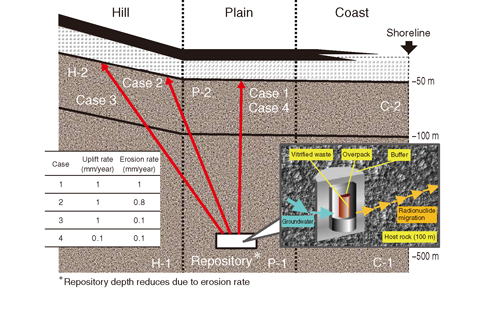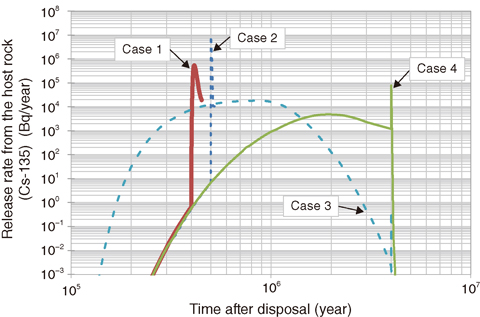
Fig.8-23 Test cases with different uplift and erosion rates

Fig.8-24 Example of release rates from the host rock (Cs-135)
The Japanese archipelago is located in the tectonically active zone around the Pacific Rim. To demonstrate the safety of a geological disposal system, potentially disruptive phenomena such as volcanism, seismicity, fault movement, and uplift/erosion must therefore also be considered for performance assessment of a geological disposal system in Japan. Uplift and erosion generally occur slowly on a regional scale, but they could gradually cause changes in the geological environment of the system whereby a repository might approach the ground surface over a very long time. Changes in the depth of the repository and the regional geography, for example, could have a significant effect on groundwater flow and geochemistry. A method focused on the difference between uplift and erosion rate has therefore been developed to evaluate the effects on the system performance as a consequence of changes in the geological environment.
In a previous study, it was conservatively assumed that the depth of a repository from the ground surface would gradually decrease, resulting in changes in groundwater flow and geochemistry. The analyses of system performance in the study were based on a conservative assumption that the uplift rate would be equal to the erosion rate so that any uplift would be instantly removed by erosion. Under actual conditions, however, it is possible that the uplift rate would exceed the erosion rate.
Thus, the current study has been trying to include this possibility in the analysis of system performance. Here, a depth of 500 m for the repository was assumed in a simple, layered sedimentary rock, and the surface geography was classified into several generic types of hill, plain, and coast, (Fig.8-23). Many parts of Japan have been subject to uplift, and hence, four test cases were defined to understand the effect of the combination of changes in depth and surface geography above the repository with time. Parameters relating to radionuclide migration affected by changes in the geological environment were also defined. Groundwater flow velocity, for example, was initially slow at deep depth, but increased as the repository neared the ground surface. The distribution coefficient for cesium (Cs)-135, which is one of dominant radionuclides in the system performance, also changed as the repository neared the ground surface. Based on such assumptions, the radionuclide migration analyses with the time-dependent parameters were executed in response to the four test cases (Fig.8-23). The relative difference between uplift and erosion rates for each test case had a significant effect upon the release rate of Cs-135 (Fig.8-24). Differences in the release rate of Cs-135 were found to be large due to the increased groundwater flow velocity near the ground surface. This study enables performance assessment with regard to uplift/erosion in a more phenomenological and quantitative manner.